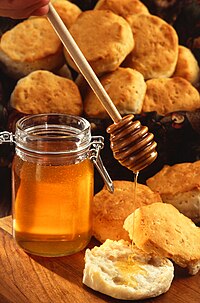
Photo from wikipedia
Trace element concentrations (As, Mn, Pb, and Zn) and Pb isotopic compositions were analyzed in honey bees, wax, and honey along with co-located soil and dust samples from Sydney metropolitan… Click to show full abstract
Trace element concentrations (As, Mn, Pb, and Zn) and Pb isotopic compositions were analyzed in honey bees, wax, and honey along with co-located soil and dust samples from Sydney metropolitan and Broken Hill, Australia. Compared with the other trace elements, Pearson correlations show that Pb concentrations in soil and dust had the strongest relationship to corresponding values in honey bees and their products. Dust Pb was not only highly correlated to corresponding soil values (r = 0.806, p = 0.005), it was the strongest predictor of Pb concentrations in honey bees, wax, and honey (p = 0.001, 0.007, 0.017, respectively). Lead isotopic compositions (206Pb/207Pb and 208Pb/207Pb) showed that honey bees and their products from Broken Hill were nearly identical (95-98%) to the composition of the local ore body. Samples of honey bees and their products collected from background sites adjacent to national parks in Sydney had Pb isotopic compositions (206Pb/207Pb = 1.138-1.159, 208Pb/207Pb = 2.417-2.435) corresponding to local geogenic values (206Pb/207Pb = 1.123-1.176, 208Pb/207Pb = 2.413-2.500). By contrast, honey bees and their products from Sydney metropolitan (206Pb/207Pb = 1.081-1.126, 208Pb/207Pb = 2.352-2.408) were similar to aerosols measured during the period of leaded petrol use (206Pb/207Pb = 1.067-1.148, 208Pb/207Pb = 2.341-2.410). These measurements show Pb concentrations and its isotopic compositions of honey bees, and their products can be used to trace both legacy and contemporary environmental contamination, particularly where sources are well documented. Moreover, this study demonstrates that legacy Pb emissions continue to be remobilized in dust, contaminating both food and ecological systems.
Journal Title: Environmental science & technology
Year Published: 2018
Link to full text (if available)
Share on Social Media: Sign Up to like & get
recommendations!